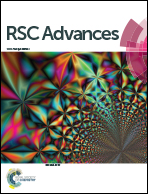Sacrificial template formation of CoMoO4 hollow nanostructures constructed by ultrathin nanosheets for robust lithium storage†
Abstract
Hierarchical hollow structures composed of two-dimensional nanostructures are desirable and challenging research subjects in the synthesis and application of nanomaterials. In the present work, CoMoO4 hollow nanostructures assembled by nanosheet subunits were successfully prepared via a facile solvothermal method using SiO2 nanospheres as the sacrificial template. In the synthesis process, the formation and assembly of CoMoO4 nanosheets, as well as the template removal, were carried out simultaneously, thus avoiding the cumbersome multi-step process of the traditional template method. The obtained nanosheets-constructed hollow nanostructures possess combined structural advantages for robust electrochemical properties as anode materials for lithium-ion batteries, such as a porous and robust framework, high surface area for electrode/electrolyte contact, reduced lithium diffusion path, and a hollow interior to accommodate the volume variation associated with the electrochemical cycles. Hence, the CoMoO4 electrode was able to deliver good lithium storage properties, including high specific capacity (1066 mA h g−1 at a current density of 500 mA g−1 after 200 cycles), good cyclic stability, and an especially excellent rate performance.


 Please wait while we load your content...
Please wait while we load your content...